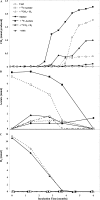Acetogens and acetoclastic methanosarcinales govern methane formation in abandoned coal mines
- PMID: 21460109
- PMCID: PMC3127600
- DOI: 10.1128/AEM.02818-10
Acetogens and acetoclastic methanosarcinales govern methane formation in abandoned coal mines
Abstract
In abandoned coal mines, methanogenic archaea are responsible for the production of substantial amounts of methane. The present study aimed to directly unravel the active methanogens mediating methane release as well as active bacteria potentially involved in the trophic network. Therefore, the stable-isotope-labeled precursors of methane, [(13)C]acetate and H(2)-(13)CO(2), were fed to liquid cultures from hard coal and mine timber from a coal mine in Germany. Guided by methane production rates, samples for DNA stable-isotope probing (SIP) with subsequent quantitative PCR and denaturing gradient gel electrophoretic (DGGE) analyses were taken over 6 months. Surprisingly, the formation of [(13)C]methane was linked to acetoclastic methanogenesis in both the [(13)C]acetate- and the H(2)-(13)CO(2)-amended cultures of coal and timber. H(2)-(13)CO(2) was used mainly by acetogens related to Pelobacter acetylenicus and Clostridium species. Active methanogens, closely affiliated with Methanosarcina barkeri, utilized the readily available acetate rather than the thermodynamically more favorable hydrogen. Thus, the methanogenic microbial community appears to be highly adapted to the low-H(2) conditions found in coal mines.
Figures



References
-
- Beckmann S., Krüger M., Engelen B., Gorbushina A. A., Cypionka H. 2011. Role of bacteria, archaea and fungi involved in methane release in abandoned coal mines. Geomicrobiol. J. 28(4):UGMB-2010-0055.R1
-
- Del Panno M., Morelli I., Engelen B., Berthe-Corti L. 2005. Effect of petrochemical sludge concentration on microbial communities during a soil bioremediation process. FEMS Microbiol. Ecol. 53:305–316 - PubMed
-
- Denman K., et al. 2007. Couplings between changes in the climate system and biogeochemistry, chapter 7. In Solomon S., Qin D., Manning M., Chen Z., Marquis M., Averyt K. B., Tignor M., Miller H. L. (ed.), Climate change 2007: the physical science basis. Contribution of Working Group I to the Fourth Assessment Report of the Intergovernmental Panel on Climate Change Cambridge University Press, Cambridge, England
Publication types
MeSH terms
Substances
Associated data
- Actions
- Actions
- Actions
- Actions
- Actions
- Actions
- Actions
- Actions
- Actions
- Actions
- Actions
- Actions
- Actions
- Actions
- Actions
- Actions
- Actions
- Actions
- Actions
- Actions
- Actions
- Actions
- Actions
- Actions
- Actions
- Actions
- Actions
- Actions
- Actions
- Actions
- Actions
- Actions
- Actions
- Actions
- Actions
- Actions
- Actions
- Actions
- Actions
- Actions
- Actions
- Actions
- Actions
- Actions
- Actions
- Actions
- Actions
- Actions
- Actions
LinkOut - more resources
Full Text Sources
Molecular Biology Databases
Miscellaneous

